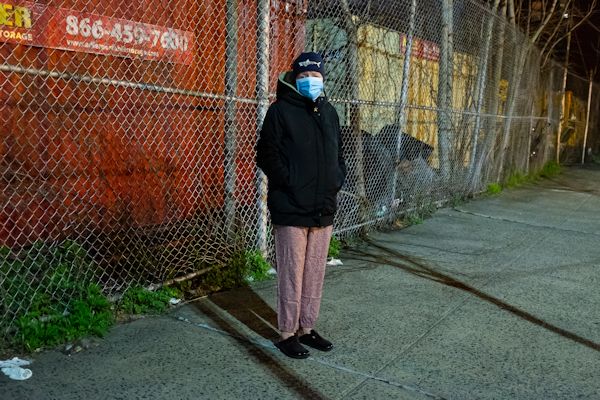SEJournal Online is the digital news magazine of the Society of Environmental Journalists. Learn more about SEJournal Online, including submission, subscription and advertising information.
 |
| The EPA left standards unchanged for particulate air pollution, even while researchers linked it to vulnerability to the coronavirus. Above, a woman wearing a mask in Red Hook, Brooklyn. Photo: Steven Pisano, Flickr Creative Commons. Click to enlarge. |
TipSheet: Ignoring COVID-19 Link, EPA Leaves Lax Soot Standard in Place
By Joseph A. Davis
The U.S. Environmental Protection Agency did nothing on April 14 — and that was news.
The agency declined to tighten the health standard for fine soot pollution in the air, despite scientific advice that such pollution worsens people’s vulnerability to the coronavirus.
It was more than bad timing (may require subscription). The decision caused consternation among public health advocates, who thought the government should help lessen the threat of COVID-19, not raise it.
One analysis found that just keeping the current standard could cost 52,000 lives a year. EPA’s own staff scientists (may require subscription) had recommended tightening it.
Why it matters
Fine, dust-like particles in the air are well-known by scientists to harm people’s lungs and cause other health problems. They call it “particulate matter,” and it can come from various sources.
The standard pollution term in science jargon for those particles is PM 10, meaning particulate matter less than 10 microns in diameter (for comparison, a human hair might be as big as 70 microns wide). Coarse particulate matter may include things like road dust.
Finer pollution is referred to as PM 2.5, meaning particles less than 2.5 microns, whether solid or liquid. Because they are so fine, they are easily suspended in the air for a longer time, which makes them easier to breathe in. These smaller particles can go farther into the lungs and may even find their way into the bloodstream.
Fine particle pollution can contain a variety of substances from a variety of sources. It may contain sulfates and nitrates (which can form acid rain and smog), pollen or soil.
Studies published recently suggest
sickness and death from COVID-19
are exacerbated by air pollution.
From a health perspective, the most important source of PM 2.5 particles is combustion (whether from cigarettes, woodstoves, car engines or power plants). This smoke may be a toxic cocktail that includes polycyclic aromatic hydrocarbons and heavy metals like arsenic.
The result, depending on how much PM 2.5 a person breathes in for how long, can be things like coughing, asthma, chronic bronchitis, reduced lung function and cancer.
Lungs thus damaged are more vulnerable to pneumonia, which is one of the fatal complications of the COVID-19 virus. Studies published recently (may require subscription) suggest sickness and death from COVID-19 are exacerbated by air pollution.
The backstory
Human health was the core purpose of the Clean Air Act of 1970, which came in a year when the smog in Los Angeles would literally sting your eyes and throat.
The act required EPA to set health-based “National Ambient Air Quality Standards,” or NAAQS, for a set of “criteria air pollutants.” There were six such pollutants, with particulates (both PM 2.5 and PM 10) being one of them.
The law requires EPA to set the NAAQS for the sole purpose of protecting human health, not considering cost, and based on science alone. The act also requires EPA to review and revise the standards every five years, as appropriate.
Over the decades, the general trend has been toward tighter NAAQS. The standard for PM 2.5 was last set in 2012 during the Obama administration (when it was tightened from 15 to 12 mg/m3).
Then EPA announced April 14 that it wanted to keep the PM 2.5 standard unchanged. It was a proposed rulemaking, which means EPA must collect public comment and submit it for White House approval before it can be finalized.
EPA staff, other scientists and environmental groups all had urged EPA to tighten the standard still further.
Story ideas
- What are the particulate levels in your neighborhood, metro area or state? How do they vary from day to day or season to season?
- What are the major sources of particulate pollution in your area? For PM 2.5? For PM 10?
- What is the record of state and federal enforcement in relation to major particulate emitters in your area? EPA’s ECHO database may help.
- Are some of the particulate sources in your area activities that do not require a permit under the Clean Air Act?
- Will protective measures like masks and air purifiers help reduce the harmful health effects of particulates, whether PM 2.5 or PM 10?
Reporting resources
- Check out your area of interest on the multi-agency AirNow website, which gives particulate levels in map form in near-real-time.
- The American Lung Association is an information and advocacy organization that works at both the national and local levels.
- Your state or local clean air agency is often a good source of information about your particular area.
- Other clean-air focused environmental advocacy groups include the Coalition for Clean Air and the Moms Clean Air Force.
- For the viewpoint of electric utilities, try the Edison Electric Institute.
Joseph A. Davis is a freelance writer/editor in Washington, D.C. who has been writing about the environment since 1976. He writes SEJournal Online's TipSheet, Reporter's Toolbox and Issue Backgrounder, as well as compiling SEJ's weekday news headlines service EJToday. Davis also directs SEJ's Freedom of Information Project and writes the WatchDog column and WatchDog Alert.
* From the weekly news magazine SEJournal Online, Vol. 5, No. 17. Content from each new issue of SEJournal Online is available to the public via the SEJournal Online main page. Subscribe to the e-newsletter here. And see past issues of the SEJournal archived here.













 Advertisement
Advertisement 



